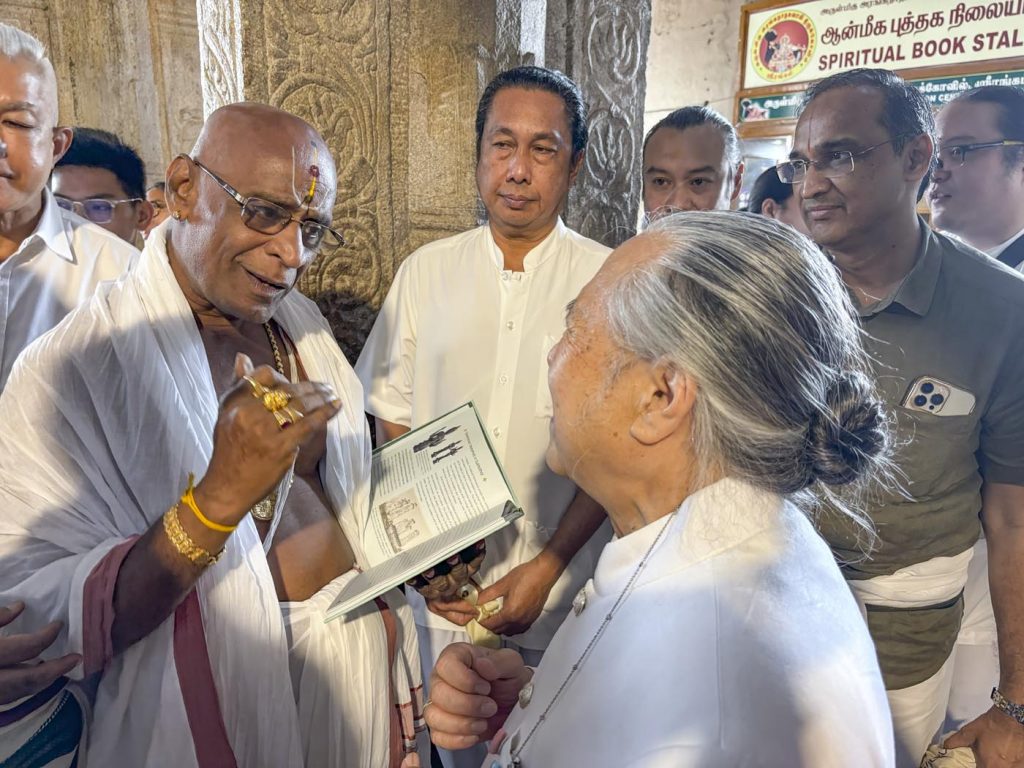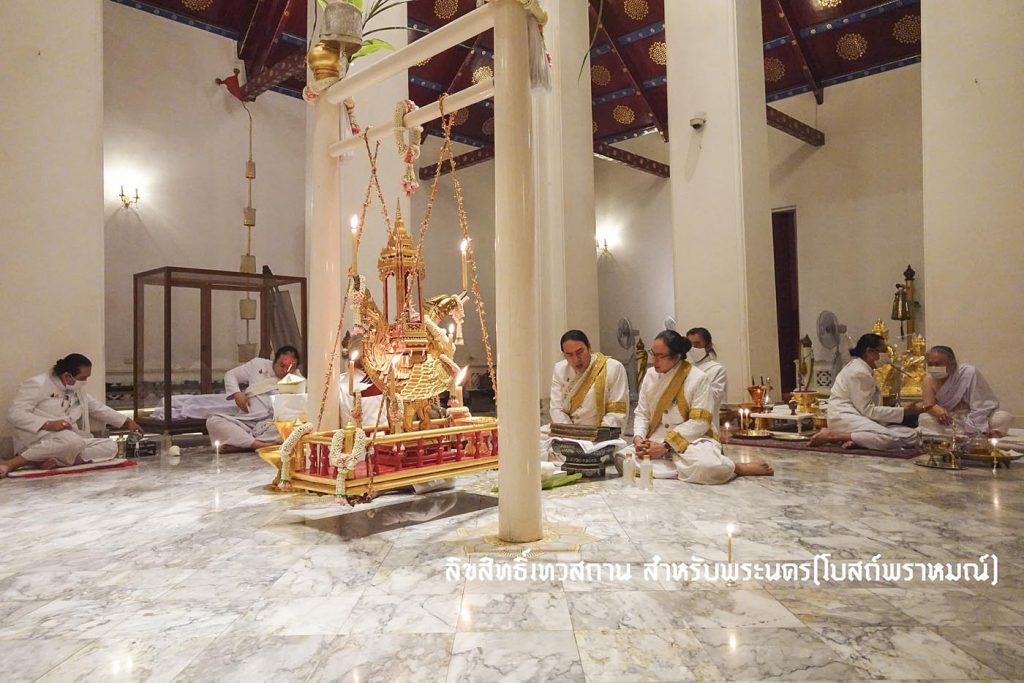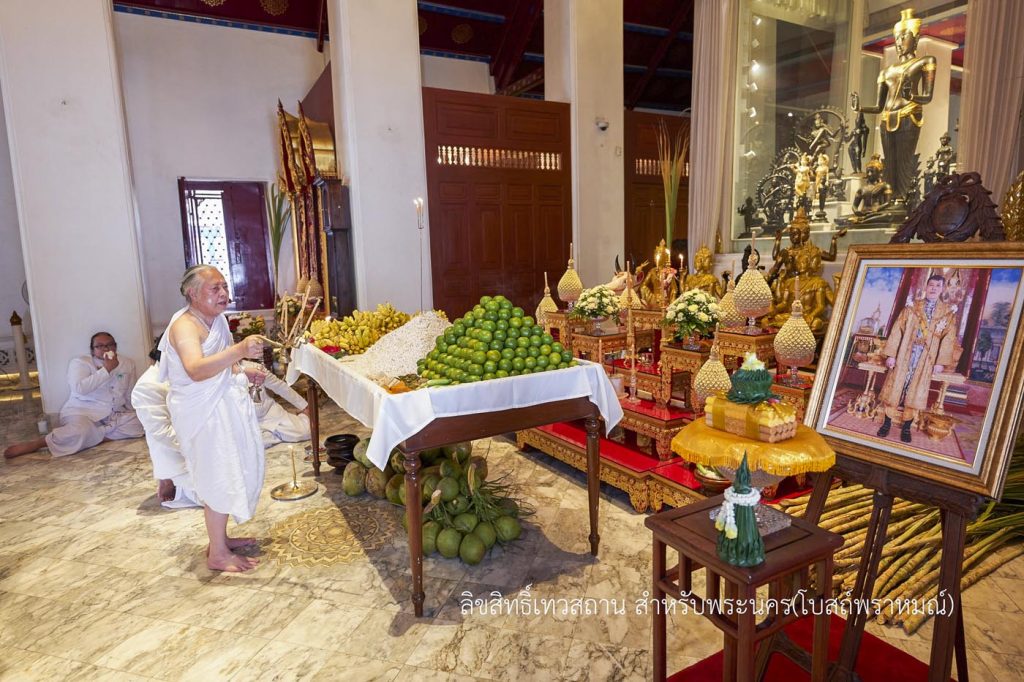For 800 years Hindu priests have guided Thailand’s royal court rituals
By Hurditya Deva, Thailand
Among the indian diaspora scattered across the globe, their settlement in Thailand, formerly known as Siam, often goes unnoticed. This likely stems from the seamless integration of Indian religions, culture and society into Thai life since ancient times. The propagation of Buddhism and Hinduism was primarily led by monks and priests who built monasteries and temples to promote their faiths. In early modern times, Hindu priests became known as Siamese Brahmins, an esteemed group headed by the Rajaguru, appointed by the monarch. They have played a pivotal role in shaping the country’s spiritual and cultural landscape since the Sukhothai period (13th–14th centuries ce) or earlier. Descendants of ancient lineages, these brahmins conduct royal ceremonies, preserve traditional rituals and provide spiritual guidance to the Thai monarchy.
Of all rituals, the most important task for the court brahmins is the royal coronation, Rajyabhisheka. After several decades, Thai people witnessed the grand coronation ceremony on May 4th, 2019, including through live telecast. The Rajaguru was at the forefront, as the head brahmin is entrusted to sanctify the sacred water collected from various rivers in Thailand and offer it to the king to bathe with, signifying the very moment he becomes the monarch. Additionally, the Rajaguru handed the royal regalia to the king as he sat on the throne, including the tiara, scepter, sword, fly whisks and parasol.
After the king was fully enthroned, the Rajaguru read a secret passage to the king, during which the telecast was muted. This solemn moment is known as “Opening of the Gate of Mount Kailash.” It is said that the passage invokes Gods to come down from Kailash to bless the king. In India, this moment would be equal to the Rajopadesha, in which the Rajaguru transmits the mantras and other teachings to a newly crowned monarch.
The Siamese Brahmins
In ancient times there were three groups of brahmins in Thailand, each divided into four branches. The Horachrya Brahmins, belonging to the Rigveda branch, served as official court astrologers, calculating auspicious times for royal ceremonies. The Adhvaryu Brahmins, from the Yajurveda branch, performed various recitations in both Thai and Sanskrit for royal and religious ceremonies. The Udgatha Brahmins, from the Samaveda branch, performed similar recitations to the Adhvaryu Brahmins. The Brahman Brahmins, from the Atharvaveda branch, conducted religious discourses and assisted other brahmins in palace rituals.
In the Rattanakosin period (1782 ce to the present day), three groups of brahmins are recorded, with the Vedic branches seemingly lost. The Vidhi Brahmins, who are Saivas, serve as the main priests at the Grand Palace. They conduct or assist the monarch in various royal ceremonies and hail from a brahmin lineage of Nakhon Si Thammarat, an ancient port where ships from India used to make stopovers before journeying to other countries in Southeast Asia. The Horacharya Brahmins, from the Sukhothai lineage, perform the same duty as official court astrologers. The Phrithibat Brahmins, from the Cambodian lineage, take care of the elephants and perform rituals related to them, including preparations for the capture of wild elephants and training them for employment at the royal court.

Similar to the brahmins in India, the Thai brahmin lineages are patriarchal, but their mothers need not necessarily be from brahmin families. However, being born into a brahmin family does not guarantee selection as court brahmins. One must undergo rigorous training and ordination, including becoming a Buddhist monk, before being eligible and proven worthy to be selected as court brahmins.
In modern times, Thai brahmins are identified by their last names, given by King Rama VI in the early 20th century, when the Western practice of having first and last names was adopted in Thailand. Last names include Gurukul, Sivayabrahman, Thavornbrahman, Chandrabrahman, Raksabrahman, Vedbrahman, Devaratna, Senakalpa, Shankhabrahman, Sucharitkul, Charusena, Chueabrahman, Vindubrahmanakul, Sirivadhanakul, Singhaseni, Svastivedin, Nagavedin, Ratnabrahman, Bhavanganang and Rangsibrahmanakul.
The Siamese brahmins’ headquarters, the Devasthana, is located at the very heart of old Bangkok, where Rama I, the founder of the present Chakri Dynasty, allocated land to build their temple. Now, the Devasthana houses three main shrines, dedicated to Siva, Ganesha and Vishnu. The temples display old Thai and Indian bronzes of Deities from different periods, including a few early Chola bronzes of Nataraja, evidence of the Thai brahmins’ connection to India.
The Present Rajaguru
Chawin Rangsibrahmanakul, 71, inherited the position of Rajaguru, with the official title “Phra Maha Rajaguru Vidhi Sri Visuddhikhun,” a role previously held by his grandfather and great-grandfather. He heads a group of 15 brahmins who have been officially ordained as the royal priests of the palace.
When he was young, besides receiving training from the senior court priests, the Rajaguru was also tutored by Vidyadhara Shukla Pandit, an Indian priest who served at the Hindu Samaj and Vishnu Mandir in Bangkok. Vidyadhara initiated Rajaguru with the Gayatri mantra and taught him Hindu scriptures. The North Indian pandit also took him to India, visiting many important pilgrimage centers in northern and southern India. He later studied Sanskrit privately with Padma Sri awardee Dr. Chirapat Prapanvidya, a professor of Sanskrit at Silpakorn University.
Outside the palace walls, the Rajaguru used to enjoy driving his classic cars around Bangkok on free days. He is also a collector of fine gems, a keen photographer and enjoys listening to Pavarotti.
The Rajaguru does not have any children. He is now mentoring young brahmins in the court rituals. In a bid to preserve and rejuvenate ancient traditions, he has sent a few young Thai brahmins to India to study subjects of their choosing under the guidance of His Holiness Vijayendra Saraswati, the current Shankaracharya of Kanchipuram. These young scholars are also receiving training in ancient Indian brahmin customs and rites, such as the Sandhyavandana.
The South Indian Connection
The present Rajaguru believes his clan, the Ransibrahmanakul, hailed from the famous Nataraja Temple of Chidambaram in Tamil Nadu. It is believed that his forefathers, the Deekshitars, embarked on a journey across the Andaman Sea hundreds of years ago and landed at Nakhon Si Thammarat port. This province contains evidence of the Indian connection in its material culture, food, performing arts and textiles. The nearby original Thai capital, Ayutthaya, was razed by Burmese in 1767ce during a war. Bangkok was later established as the new capital city in 1782. Brahmins who had been scattered in the war’s aftermath were regrouped and brought to officiate the royal coronation and other state ceremonies, legitimizing the new reign.

Although there is no written or epigraphical record of their ancestors hailing from Chidambaram, one of the most significant clues lies in the royal brahmins’ core hymns. These hymns, the Thiruvempavai and Thiruppavai, are chanted during their most important liturgy of the year in the original Tamil, despite the brahmins not speaking any Tamil and using a unique tune that differs significantly from the version sung in South India. The hymns are recorded on manuscripts made of mulberry bark, written in the Thai Grantha script, which few people have the knowledge to read. The Thiruvempavai and Thiruppavai festivals take place in December or January, which falls in the Tamil month of Margazhi.
In Tamil Nadu, these hymns—Thiruvempavai dedicated to Siva and Thiruppavai dedicated to Vishnu—are still chanted today, but separately in each God’s respective temple. The Thiruvempavai, composed by the Saiva saint Manikkavacagar, is part of the larger collection known as Thiruvasagam. The Thiruppavai, composed by the female saint Andal, is within a collection of the Tamil Divya Prabandham composed by twelve Vaishnava saints (Alvars).
In the Thiruvempavai, Lord Nataraja is praised many times. It is also believed that this hymn was first chanted by the saint-composer himself in the presence of the Lord in front of Chitsabha (the sanctum sanctorum of Nataraja). It is customary to chant “Thiru Chidambaram,” which can be loosely translated as “Hail to the Holy Chidambaram,” at the very beginning of the hymn. Thus, it is not surprising that Nataraja is worshiped as the main Deity at the Devasthana and why the Rajaguru firmly believes he is a descendant of the priests of the famed Nataraja temple. It is unique that the aforementioned hymns of Siva and Vishnu are chanted at the Devashana in the same precinct. On the first ten days, Thiruvempavai is chanted in the Siva temple, followed by the Thiruppavai during the next ten days in the Vishnu temple.

The festival culminates in the “Giant Swing” ceremony, which involves the worship of a large wooden plank along with celestial bodies like the Sun, Moon, Mother Earth and the river Goddess Ganga. After the worship, the plank is fixed with ropes, hung on poles, and mounted by a court official and a brahmin known as nalivan. In this ritual, the brahmin symbolizes a naga, while the court official, representing the king, symbolizes Siva. The “Giant Swing” itself (photo right) is no longer used, deemed too dangerous.
The ritual corresponds to a mythological story recounting a bet between Siva and Parvati. Parvati doubts the stability of the earth, and Siva proves her wrong by asking a naga to stretch itself between two trees while He stands on it on one leg as the naga swings about. This imagery is also reminiscent of the image of Nataraja, representing the cosmic dance of Siva. Furthermore, the myth bears resemblance to the sumudramanthana (churning of the milky ocean) ,where Gods and demons battle over the elixir of immortality, a giant sculpture of which greets visitors at Bankok’s main airport.
It’s worth noting that Thai kings in the Chakri dynasty have regnal names prefixed with “Rama,” such as the current monarch, Rama X. This tradition signifies the belief that the kings embody Vishnu, who is revered as the ideal king in numerous ancient Hindu scriptures. However, the most important liturgy at the Devasthana is dedicated to Siva. This coexistence of Saivism and Vaishnavism in Thailand demonstrates a unique blend and tolerance not commonly seen in India in the past.


Twelve-Month Ceremonial Cycle
After the fall of Ayutthaya in 1776, many royal liturgies conducted by the brahmins were discontinued. King Chulalongkorn (Rama V) compiled a work based on written and oral records called The Royal Ceremonies of Twelve Months. The book outlines various sacred and secular ceremonies (see sidebar for list) that the Ayutthaya kings conducted every month for the welfare of the state and the people. Many of these ceremonies are undoubtedly Indian in origin and were most likely conducted by brahmins, while others are Buddhist in nature, military or socially related. The first Thai month begins in December and ends in November. There were probably many more rituals per month, but the knowledge was likely lost. Today, the book serves as the only record of ceremonies in the premodern history of Thailand. A handful are still conducted today.

The court brahmins also conducted several rite-of-passage rituals known as samskaras. One of few such rituals still performed in the modern period is the tonsure ceremony, where a hair tuft of a young boy is cut, signifying his transition into adulthood. Moreover, the brahmins participate in palace Buddhist ceremonies, such as the changing of the costume of the Emerald Buddha, which occurs at the beginning of each season.
In the Contemporary World
In modern times, the Rajaguru faces an array of new challenges. Rapid urbanization, technological advancement, and global influences pose significant questions about the preservation of traditional values and practices. The swift pace of change can sometimes overshadow ancient customs, creating a tension between maintaining cultural heritage and embracing modernity. Despite these changes, the Rajaguru’s role remains as vital as ever, providing a stabilizing force in a rapidly evolving world.
The Rajaguru frequently visits pilgrimage centers of South India, to which he has an affinity due to his link with Chidambaram. These visits are not just spiritual journeys but also opportunities for cultural exchange and scholarly interaction. After a long absence due to the lockdowns and a tight schedule, including the king’s coronation, the Rajaguru and fellow royal brahmins most recently visited India in February 2024. They first paid a visit to His Holiness Sri Vijayendra Saraswati at the Kanchi Mutt, discussing the establishment and exchange of knowledge and research, which the government of India has expressed willingness to support. This includes digitization projects of Thai and Indian manuscripts and comparisons of chanting styles, such as those of the Thiruvempavai and Thiruppavai, as well as studying ancient Indian migration routes to Southeast Asia. Such initiatives are crucial in preserving the rich tapestry of spiritual traditions and understanding their historical spread and influence.


Next they visited Chidambaram, where a group of Deekshitars awaited and welcomed Rajaguru with a parade that led him to witness abhisheka of the ruby Nataraja and crystal Sivalinga. Srirangam was the next stop. After darshan of Sri Ranganatha, the reclining Vishnu, they visited surrounding shrines, making a longer stop at the Andal shrine, where a few Vaishnava priests demonstrated the chanting of the Thiruppavai. The Rajaguru noted that some pasurams (chapters) resemble chants at the Devasthana. In Thailand, the Thiruvempavai and the Thiruppavai are not chanted outside the festival in December/January, unlike in India where they can be chanted in homes and as an upacara (service) to the Deities in temples on other important occasions.
The group ended the South Indian pilgrimage at Rameshwaram, welcomed by descendants of the Sethupathi clan, hereditary custodians of the temple. Rajaguru offered the abhisheka to the Jyotirlinga, after which the young Thai priests got a chance to bathe with water from the twenty-two sacred wells for the first time.

Talking about the younger generation, there are currently few practicing brahmin priests left in Thailand. Many born into brahmin families have chosen careers in business or the corporate world, driven by the demands and opportunities of contemporary society. Besides officiating royal ceremonies in the palace, a handful of priests earn their living by establishing spirit shrines, conducting housewarming ceremonies, inaugurating businesses and practicing astrology. This diversification of roles reflects the adaptive nature of brahmin priests in the face of modern economic realities.


Conclusion
Adapting to these changes while preserving the essence of Thai spirituality is delicate. The current Rajaguru, like his predecessors, navigates it with integrity and wisdom. He ensures that Hindu teachings, which have harmoniously merged with Buddhism, remain relevant and accessible to society. The fusion of Brahmanical and Buddhist traditions in the Thai ceremonial calendar exemplifies Thailand’s unique cultural identity and underscores the importance of continuity and adaptation in preserving ancient traditions in a modern context.
Historical Rituals
❃ December: Royal Boat Ceremony. It was held immediately after the monsoon season. During the Ayutthaya period, this ritual was of great importance as the city, essentially an island surrounded by rivers, was prone to flooding. The king and his family, dressed as Deities, sailed on a royal barge, believing their divine presence would lower water levels and protect the rice fields.
❃ January: Thiruvempavai and Thiruppavai Festival. It is the grandest brahmanical ritual in Thailand.
❃ February: Royal Plowing Ceremony. Marking the beginning of the agricultural season, the brahmins conducted the sacred plowing of the field to ensure a bountiful harvest.
❃ March: Paying Homage to Teachers. Students offered flowers, incense and candles to their teachers as a symbol of respect and appreciation.
❃ April: New Year and Water Blessing. Priests chanted and sprinkled holy water on participants, for purification and renewal.
❃ May: Second Royal Plowing. Similar to February, this one also included the release of sacred oxen, which were believed to predict the agricultural fortunes of the year based on the food they chose to eat.
❃ June: Homage to Land Guardians. This ritual was performed to honor the Deities and spirits that protect the land and its inhabitants..
❃ July: Buddhist Lent. This marked the beginning of the rainy-season retreat for Buddhist monks.
❃ August: Welcoming the Monsoon. Lord Varuna was invoked to ensure sufficient rainfall for the agricultural season.
❃ September: Rice Harvest. New rice was offered to express gratitude to spirits and Deities for a bountiful harvest.
❃ October: Ancestor Worship. Offering food, flowers and incense to ancestral spirits along with sacred chants to invoke their blessings.
❃ November: Loy Krathong. This marks the end of the Thai ceremonial calendar. Participants float decorated baskets on waterways to seek forgiveness for any harm caused to bodies of water.
About the author

Hurditya Deva is an opera singer and scholar, with a Masters and PhD in Sanskrit Studies. He researches Sanskrit texts and epigraphy in India and Southeast Asia.

Very interesting article. i studied history in the University of Malaya from 1971-1973 and one of my core pares was The Indianization of SouthEast Asia.